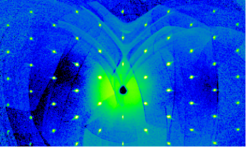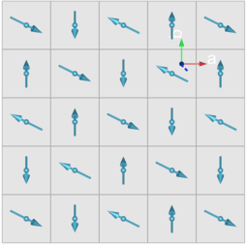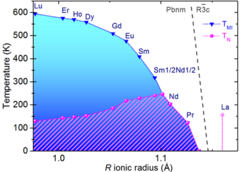LaNiO3: a highly metallic strongly correlated oxide with antiferromagnetic correlations
The rare earth nickelates RNiO3 (R = rare earth, Y) with the high Ni3+ oxidation state have continued to attract enormous interest due to the famous bandwidth controlled metal-insulator transition and associated unusual charge and spin-order phenomena together with the prediction for multi-ferroicity and even superconductivity in thin film hetero-structures. The description of the underlying physics of these phenomena turned out to be a true intellectual challenge and important theoretical concepts have been and still need to be developed.
One of the long standing puzzles is why LaNiO3 seems to be the only RNiO3 that stays metallic and paramagnetic down to lowest temperatures. Along the RNiO3 series, the octahedral tilts become smaller with increasing R-ionic radius. Thus, the Ni–O–Ni bond angles become larger, which alters the electronic bandwidth and the magnetic exchange interactions. A lowering of the metal-transition temperature can be observed together with an increase of the antiferromagnetic transition temperature. With La having the largest ionic radius of the series, one should expect the strongest antiferromagnetic properties for LaNiO3. However, so far it was reported that LaNiO3 does not show any magnetic order at all and thus violates the trend.
Here, we report on the successful growth of large centimeter-sized LaNiO3 single crystals by the floating zone technique. Electrical resistivity and Hall effect measurements on our single crystals show that LaNiO3 is intrinsically not a bad metal as recently discussed for the RNiO3 (R = Pr-Lu, Y) compounds in their paramagnetic phase. On the contrary, we found that LaNiO3 has a high conductivity. Moreover, we were able to observe bulk antiferromagnetism in magnetization, specific heat, and neutron scattering experiments. The ordering temperature is relatively high: TN = 157 K. Thus, LaNiO3 appears to be a highly metallic and antiferromagnetic transition metal oxide—a rather rare combination in oxides. Special about LaNiO3 is that it is also very close to an insulating state, making LaNiO3 an intriguing quantum material, probably close to a quantum critical point, where strong local electronic correlations at the Ni sites are likely to interfere in an intricate manner with Fermi surface effects.
The decisive step forward that we have made is our success to produce single crystals of LaNiO3. Hundreds of publications are dealing with this class of high oxidation state Ni oxide materials. However, the vast amount of research in literature is based on powder or polycrystalline samples only. It turned out that the true electric and magnetic properties of LaNiO3 can only be uncovered if single crystals are used which are also free from NiO impurities. This was possible only if the material is grown under high oxygen pressures. Thanks to the availability of the 150 bar high pressure mirror furnace in our Physics of Correlated Matter Department, the team around Alexander Komarek was able to synthesize single crystals, see Fig. 1, large enough also for neutron scattering experiments, see Fig. 2. As a consequence, the entire well-known RNiO3 phase diagram had to be changed, see Fig. 3. These new results on LaNiO3 open up new thoughts about how to explain the properties and the electronic structure of these high oxidation state materials.
ACK, LHT / CPfS

Fig. 1 X-ray scattering intensities within the HK0 plane of reciprocal space obtained in a single crystal X-ray diffraction experiment on LaNiO3.

Fig. 2 A spiral spin arrangement that is consistent with the neutron scattering experiments on cm-sized LaNiO3 single crystals.

Fig. 3 New tentative phase diagram of the RNiO3 system.


